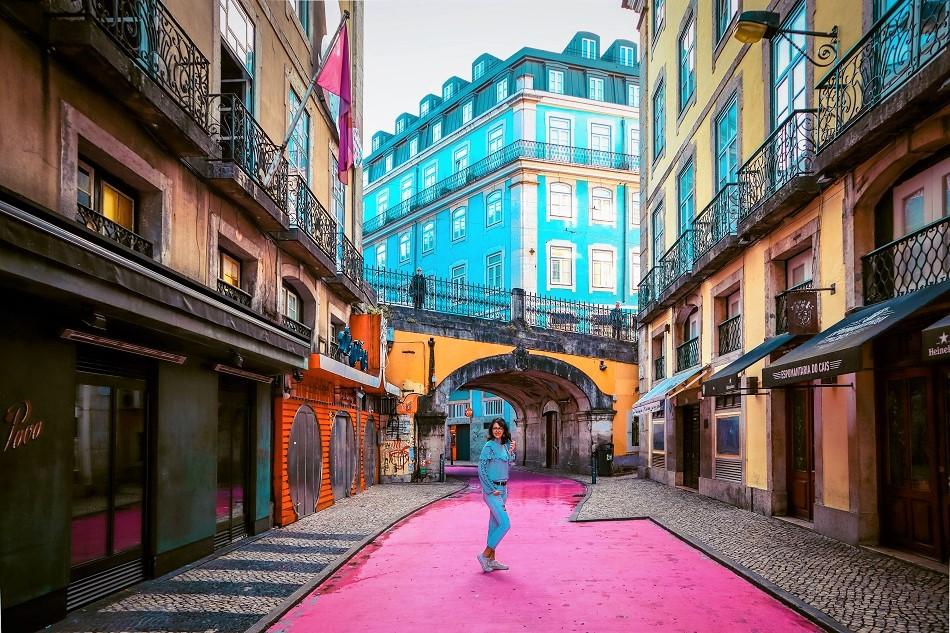Pink Street Lisbon: Where Culture, Color, and Nightlife Converge in Portugal’s Vibrant Capital

Introduction:
Nestled in the heart of Lisbon, Portugal, the Pink Street, or “Rua Nova do Carvalho,” stands as a vibrant testament to the city’s dynamic spirit, cultural renaissance, and lively nightlife. Formerly an area known for its connection to the city’s maritime history, this cobblestone street has undergone a transformative journey, evolving into a lively hub where the past and present coalesce. This extensive exploration invites you to traverse the captivating Pink Street, revealing its historical roots, vibrant atmosphere, and the kaleidoscope of experiences it offers to both locals and visitors alike.
Historical Roots:
Maritime Legacy: Originally part of Lisbon’s bustling waterfront, the Pink Street has a rich maritime legacy that dates back to the city’s heyday as a prominent port. Its proximity to the Tagus River and the historic Cais do Sodré district made it a vital hub for sailors, merchants, and locals engaged in maritime activities.
Transformation Over Time: As Lisbon underwent urban development and modernization, the area surrounding Pink Street saw shifts in its character. What was once a connection to the maritime industry gradually transformed into a diverse and lively neighborhood, with Pink Street at its core.
Vibrant Atmosphere:
A Splash of Color: What sets Pink Street apart is its distinctive pink hue, which covers the entire street surface. The choice of color is not merely aesthetic; it’s a deliberate effort to infuse vibrancy into the urban landscape. The pink color scheme radiates energy, making the street instantly recognizable and contributing to its unique ambiance.
Artistic Expressions: Pink Street is not limited to its color; it serves as a canvas for artistic expressions. The facades of the surrounding buildings boast colorful murals, street art, and graffiti, adding an extra layer of creativity to the area. Each piece of art tells a story, contributing to the cultural richness of Pink Street.
Cobblestone Charm: The cobblestone pavement, a characteristic feature of Lisbon’s historic districts, adds to the charm of Pink Street. The textured surface, worn smooth by the passage of time, creates a tactile experience for those strolling along its length. It’s a reminder of the street’s historical roots and an integral part of Lisbon’s architectural heritage.
Nightlife and Entertainment:
Thriving Night Scene: As the sun sets, Pink Street comes alive with a diverse array of nightlife options. It has become a hotspot for locals and tourists seeking entertainment, with a plethora of bars, clubs, and restaurants lining its sides. The street’s transformation from a daytime cultural hub to a nightlife destination showcases its versatility and adaptability.
Eclectic Venues: Pink Street is home to a variety of venues, each offering a unique atmosphere. From laid-back bars where patrons can enjoy a leisurely drink to high-energy clubs pulsating with music, there’s something for everyone. The eclectic mix of venues contributes to Pink Street’s reputation as one of Lisbon’s most diverse nightlife districts.
Live Music and Performances: Live music reverberates through the air, drawing music enthusiasts to Pink Street’s vibrant venues. The street hosts an array of performances, from local bands showcasing Portugal’s musical heritage to international acts that contribute to the city’s cosmopolitan appeal. The dynamic nightlife scene ensures that Pink Street remains a key player in Lisbon’s after-dark entertainment.
Culinary Delights:
Gastronomic Variety: Beyond its nightlife, Pink Street is a culinary haven, offering a diverse range of dining options. From traditional Portuguese eateries serving iconic dishes to trendy restaurants experimenting with global flavors, the street caters to every palate. Visitors can embark on a gastronomic journey, exploring the flavors that define Lisbon’s culinary landscape.
Al Fresco Dining: The street’s design encourages al fresco dining, with many establishments offering outdoor seating. As patrons savor their meals, they become part of the vibrant street scene, absorbing the energy of Pink Street and its surroundings.
Practical Tips:
- Visit in the Evening: To fully experience Pink Street’s lively atmosphere, plan your visit in the evening when the nightlife is in full swing. The street transforms into a dynamic hub of activity as dusk descends.
- Explore Nearby Areas: Pink Street is centrally located, making it convenient to explore nearby districts such as Cais do Sodré and Bairro Alto. These areas offer additional cultural and entertainment options.
- Respect Local Customs: While Pink Street has a vibrant nightlife, it’s essential to be mindful of local customs and maintain respectful behavior, especially during late-night hours.
- Public Transportation: Given Pink Street’s central location, consider using Lisbon’s efficient public transportation system to reach the area. The Cais do Sodré metro and train station are nearby, providing easy access.
Conclusion: Lisbon’s Pink Gem
In conclusion, Pink Street in Lisbon encapsulates the essence of the city’s evolution – a colorful tapestry woven with threads of history, culture, and modernity. Whether exploring its cobblestone charm during the day or immersing oneself in the vibrant nightlife, Pink Street is a destination that beckons travelers and locals alike. As a symbol of Lisbon’s resilience and adaptability, Pink Street remains a dynamic gem, inviting all who walk its length to be part of the lively narrative that continues to unfold on this iconic stretch of urban brilliance.




